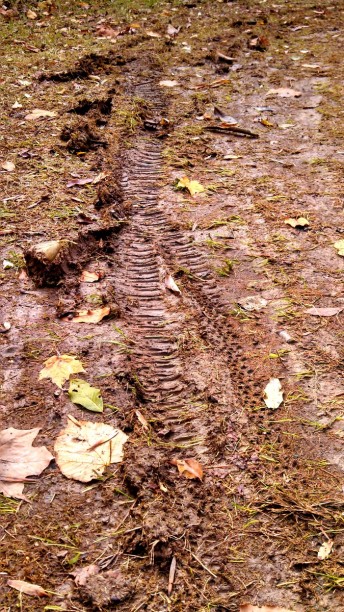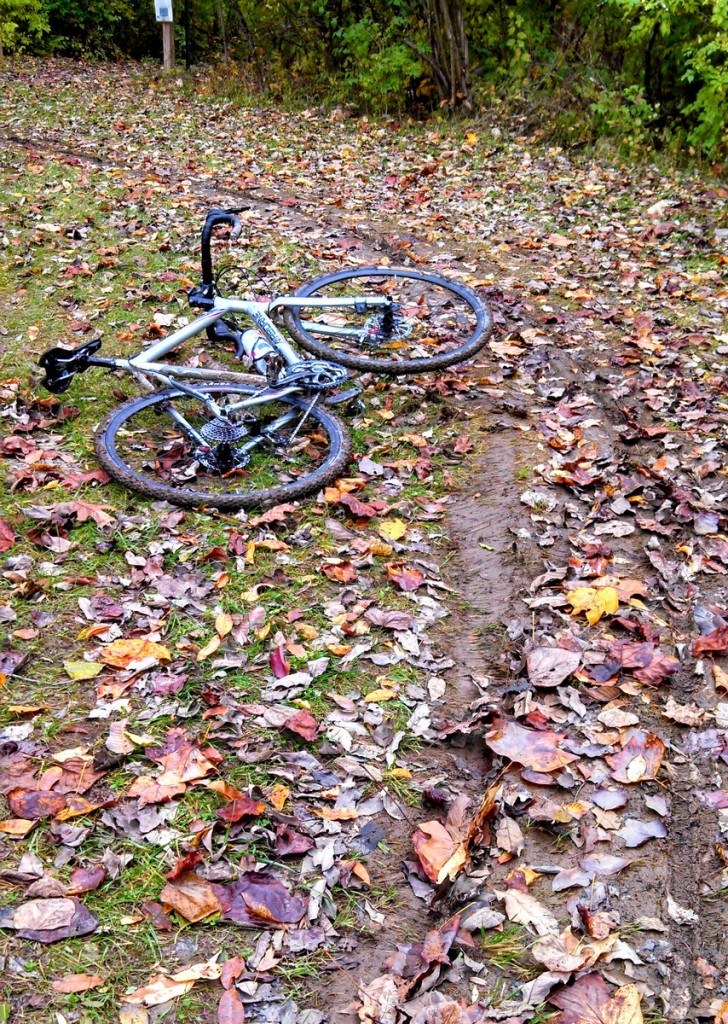After our trail work day, I figured it was a good opportunity to get some more practice on my ‘cross bike. The race course from the OVCX weekend is still quite visible in the grass, and I’ve been using it whenever I have a chance to work on my fitness and skills.
Besides not having lungs big enough (boy, can those guys ever hammer…), one of my big limiting factors in cyclocross has been my bike handling skills. Despite being, at first glance, the halfway point between road cycling and mountain biking, there hasn’t been as much skill transfer to CX as I would have guessed. I often find myself tiptoeing through turns that I should rail, just from a lack of confidence. On a course with as many twists and turns as your typical CX course, that can add up to a lot of time lost in just a single lap.
The problem compounds. I’m not carrying enough speed through the corners, which makes me work harder in the straights to make up time, which exhausts me more quickly than my more experienced competitors, which makes me rush corner entries, which squanders my exit speed, which makes me have to work harder in the straights… It all adds up to me getting gapped within the first lap. The only solution to this is seat time, which I’ve been grabbing whenever I can. With my mountain bike in the shop, and the weather getting a little cold to enjoy a road bike ride, focusing on the ‘cross bike has been pretty easy.
Fortunately, some of my motorcycle experience comes into play with this problem. While it’ll take some time to figure out what I’m doing wrong and correct it, I at least have the tools to approach and evaluate what I’m doing and what I need to do to fix it. Line choice affects exit speed, and one of the first things I’ve noticed is that I’m approaching the corners too narrow, or towards the inside of the turn. This effectively makes the turn sharper than it should be, lowering my speed mid-corner and leaving me in a hole at the exit. It’s a fine tactic when you’re in the lead, because it makes you very hard to pass. But let’s face it, I’m not in danger of being in that position any time soon.
Line choice is an easy enough problem to correct. It only takes a few laps of repetition, slowing down and making deliberate choices as you enter each corner until it becomes habit. But it rolls me right into my next problem, and that’s understanding the limits of the available traction. On a race track, the ideal race line gets better as the day goes on, as more rubber is laid down and traction increases. On a cyclocross course, the more bikes go through a corner, the more sketchy the ideal line can become. To be able to carry speed through a wide, sweeping line, you have to know exactly how much speed and lean angle are too much. Finding that limit is a classical exercise in trial and error, and lately, the balance of my efforts have been error.
This is an area where neither my experience on asphalt or dirt really helps me, because of the difference in visual cues and variety of surfaces involved in cyclocross. On a racetrack, the pavement is more or less consistent, as is the level of grip that goes with it. There are bumps and patches, but they’re pretty obvious, and after a few laps of experimentation, you know what you can expect from them. Likewise, on singletrack trail, the traction can vary dramatically based on the conditions. But the visual cues are straightforward and plentiful most of the time, so as long as you know what to look for, you can adjust on the fly.
Cyclocross is just a hot mess. You’re riding on grass, and mud, and hard-packed dirt, and through sand, and occasionally on pavement. One corner may look very much like the next, but the available grip can be entirely different. You’re going as fast or faster than you would on a mountain bike, except that the surface you’re riding on is often obscured, and so your best gauge for how well your tires will hold is to simply toss it in and find out.
Part of the art of cornering a cyclocross bike is becoming comfortable and proficient sliding the bike. This is made more difficult by the fact that a rigid bike provides very little warning or compensation for a loss in traction, so the difference between a controlled slide and ending up on your head can be slight. Just how slight, I found out while practicing on a soggy course at John Bryan. I found myself on my back twice in as many laps, the victim of just a tiny bit too much speed on mud that was covered in grass and leaves.
Nobody likes crashing, and I especially hate having to clean mud out of my components. But this is the sort of thing that’s involved when you’re finding the limit. If I’m going to get good at this cyclocross thing, it’s something I’ll have to become accustomed to.



[…] up for the occasion. The ‘cross bike was pretty well caked over with mud, after I kept crashing it in practice at JB, so I wanted to give it a proper once over to make sure everything was still in rig. Happily, […]